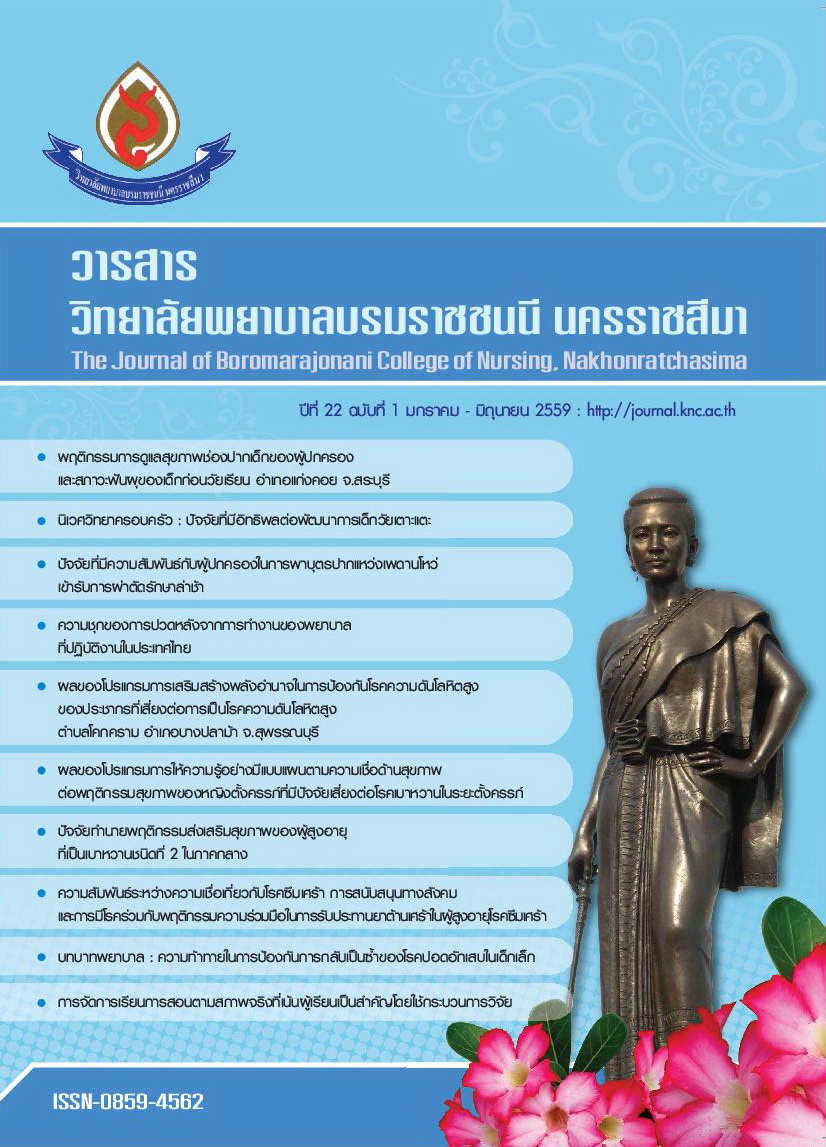ปัจจัยทำนายพฤติกรรมส่งเสริมสุขภาพของผู้สูงอายุที่เป็นเบาหวานชนิดที่ 2 ในภาคกลาง
คำสำคัญ:
พฤติกรรมส่งเสริมสุขภาพ, ผู้สูงอายุที่เป็นเบาหวานชนิดที่ 2, การรับรู้อุปสรรค, การรับรู้สมรรถนะ, Health Promoting Behaviors, Elders with Type 2 Diabetes, Perceived barriers, Self - Efficacyบทคัดย่อ
การวิจัยนี้เป็นการวิจัยหาความสัมพันธ์เชิงทำนาย เพื่อศึกษาพฤติกรรมส่งเสริมสุขภาพของผู้สูงอายุที่เป็นเบาหวานชนิดที่ 2 ในภาคกลาง และอำนาจการทำนายระหว่างปัจจัยส่วนบุคคล การรับรู้ประโยชน์ของการปฏิบัติพฤติกรรมสุขภาพ การรับรู้อุปสรรคในการปฏิบัติพฤติกรรมสุขภาพ และการรับรู้สมรรถนะของตนเองในการปฏิบัติพฤติกรรมส่งเสริมสุขภาพต่อพฤติกรรมส่งเสริมสุขภาพ ตามกรอบแนวคิดของเพนเดอร์ (Pender, 1996) กลุ่มตัวอย่างคือผู้สูงอายุที่เป็นเบาหวานชนิดที่ 2 ในภาคกลาง จำนวน 118 ราย ที่มารับบริการในหอผู้ป่วยใน จำนวน 6 โรงพยาบาลในภาคกลาง สุ่มตัวอย่างแบบแบ่งชั้น ระหว่างเดือนพฤษภาคม 2557 – กรกฎาคม 2558 เครื่องมือที่ใช้ในการวิจัยเป็นแบบสอบถามที่ดัดแปลงมาจากแบบสอบถามของนันติยา ตอโคกสูง (2554) ได้ค่าดัชนีความตรงของเนื้อหา (content validity index) ของแบบสอบถามพฤติกรรมส่งเสริมสุขภาพ การรับรู้ประโยชน์ของพฤติกรรมส่งเสริมสุขภาพ การรับรู้อุปสรรคของพฤติกรรมส่งเสริมสุขภาพ การรับรู้สมรรถนะของตนเองในการปฏิบัติพฤติกรรมส่งเสริมสุขภาพได้เท่ากับ .90, .92, .86 และ .86 ตามลำดับ ค่าสัมประสิทธ์อัลฟ่าครอนบราค (Cronbach , s coefficient alpha) เท่ากับ .89, .95, .89, .87 ตามลำดับ วิเคราะห์ข้อมูลด้วยสถิติความถี่ ร้อยละ สหสัมพันธ์เพียร์สันและวิเคราะห์การถดถอยเชิงพหุแบบปกติ (Enter regression)
ผลการวิจัยพบว่าผู้สูงอายุที่เป็นเบาหวานชนิดที่ 2 ในภาคกลาง มีคะแนนเฉลี่ยของพฤติกรรมส่งเสริมสุขภาพโดยรวมอยู่ในระดับมาก (= 3.69, S.D. = .53) การศึกษา ระยะเวลาที่ได้รับการรักษาโรคเบาหวาน การรับรู้ประโยชน์ของพฤติกรรมส่งเสริมสุขภาพ การรับรู้อุปสรรคของการปฏิบัติพฤติกรรมส่งเสริมสุขภาพ และการรับรู้สมรรถนะของตนเองในการปฏิบัติพฤติกรรมสุขภาพ มีความสัมพันธ์ทางบวกกับพฤติกรรมส่งเสริมสุขภาพ (r = .246, .256, .258, .283, .338 ตามลำดับ) อย่างมีนัยสำคัญทางสถิติที่ระดับ .01 การรับรู้อุปสรรคของการปฏิบัติพฤติกรรมส่งเสริมสุขภาพ การรับรู้สมรรถนะของตนเองในการปฏิบัติพฤติกรรมส่งเสริมสุขภาพ การศึกษา และระยะเวลาที่ได้รับการรักษาโรคเบาหวาน สามารถร่วมกันทำนายพฤติกรรมส่งเสริมสุขภาพได้ร้อยละ 28.3 ที่ระดับนัยสำคัญทางสถิติ .05 ผลการวิจัยในครั้งนี้ชี้ให้เห็นว่าควรมีการส่งเสริมให้ผู้สูงอายุที่เป็นโรคเบาหวานชนิดที่ 2 รับรู้อุปสรรคและรับรู้สมรรถนะแห่งตนในการปฏิบัติพฤติกรรมส่งเสริมสุขภาพเพื่อนำไปสู่การควบคุมภาวะแทรกซ้อนและส่งเสริมให้ผู้สูงอายุที่เป็นเบาหวานชนิดที่ 2 มีสุขภาพโดยรวมดีขึ้น
Factors Predicting Health Promoting Behaviors of the Elderlys with Type 2 Diabetes in the Central Region of Thailand
Abstract
The purposes of this predictive correlation study were to investigate health promoting behaviors, education, period of treatment for diabetes, perceived barriers, and self efficacy and predicting factors of health promoting behaviors of the elders with type 2 diabetes in the Central Region of Thailand. The Health Promotion Model developed by Pender (1996) was adopted and provided the conceptual framework for this study. The study,s sample of 118 participants were selected during the period May 2014 – July 2015, using simple random sampling from the inpatient unit of 6 hospitals located within the Central Region of Thailand. Participants completed the health promoting behaviors questionnaire adapted from Nantiya Torkoksung (2011). The reliability of health promoting behavior, benefits, barriers and self – efficacy of health promoting behavior was tested using Cronbach,s coefficient alpha with the results of .89, .95, .89 และ .87 respectively. Data were analyzed by using frequency, percentage, and enter multiple regression.
The results showed that overall health behaviors of the elderly with type 2 diabetes in the Central Region were at good level (= 3.69, S.D. = .53) Education, duration of treated diabetes, perceived benefits, barriers, and self - efficacy of health promoting behavior showed statistically significant positive correlation to health promoting behaviors to help elderly with diabetes at .01 level (r = .246, .256, .258, .283, .338) and education, duration of treated diabetes. Perceived benefits, barriers, and self - efficacy of health promoting behavior were the joint factors that can predict the health promoting behaviors at 28.3 percent (p < .05). This study suggest that there should be to encourage elderly with type 2 diabetes perceived barriers and self - efficacy of health promoting behaviors lead to control complications and encouraging elderly with type 2 diabetes have better overall health.
ดาวน์โหลด
ฉบับ
ประเภทบทความ
สัญญาอนุญาต
บทความที่ได้รับการตีพิมพ์เป็นลิขสิทธิ์ของ วารสารสุขภาพและการศึกษาพยาบาล ซึ่งดำเนินการโดยวิทยาลัยพยาบาลบรมราชชนนี นครราชสีมา
ข้อความที่ปรากฏในบทความในวารสารเล่มนี้เป็นความคิดเห็นส่วนตัวของผู้เขียนแต่ละท่านไม่เกี่ยวข้องกับกองบรรณาธิการวารสารสุขภาพและการศึกษาพยาบาล หรือวิทยาลัยพยาบาลบรมราชชนนี นครราชสีมา แต่อย่างใด ความรับผิดชอบองค์ประกอบทั้งหมดของบทความแต่ละเรื่องเป็นของผู้เขียนแต่ละท่าน หากมีความผิดพลาดใดๆ ผู้เขียนแต่ละท่านจะรับผิดชอบบทความของตนเองแต่ผู้เดียว







